The AMD 2nd Gen Ryzen Deep Dive: The 2700X, 2700, 2600X, and 2600 Tested
by Ian Cutress on April 19, 2018 9:00 AM ESTPrecision Boost 2 and XFR2: Ensuring It Hertz More
One of the biggest changes for the new Ryzen-2000 series is in how the processor implements its turbo. Up until this point (except the recent APU launch), processors have relied on a step function implementation: the system determines how many threads are loaded, attempts to implement a specific frequency on those cores if possible, and then follows the look-up table relating thread count to frequency. AMD’s goal in Precision Boost 2 is to make this process more dynamic.
This image from AMD is how the feature is being represented: the system will determine how much of the power budget is still available, and turbo as much as possible until it hits one of the limiting factors. These factors can be any of, but not limited to, the following:
- Total chip peak power
- Individual core voltage/frequency response
- Thermal interactions between neighboring cores
- Power delivery limitations to individual cores/groups of cores
- Overall thermal performance
AMD’s new Ryzen Master 1.3 software, when used on a Ryzen 2000-series processor, has several indicators to determine what the limiting factors are. For the most part, the way the processor will boost and respond to the environment, will be transparent to the user.
The best way to test this in action, from my perspective, is to look at the power draw of the first generation and second generation Ryzen processors. We can examine the internal estimated power consumption of each core individually as thankfully AMD has left these registers exposed, to give the following data:
This is only the core consumption power, not the package power, which would include the DRAM controller, the Infinity Fabric, and the processor IO. This means we get numbers different to the rated TDP, but the danger here is that because the Ryzen 7 2700X has a 10W TDP higher than the Ryzen 7 1800X, where the 2700X draws more power it could seem as if that is the TDP response.
Just plotting the power consumption gives this graph:
Even in this case it is clear that the Ryzen 7 2700X is drawing more power, up to 20W more, for a variable threaded load. If we change the graph to be a function of peak power:
The results are not quite as clear: it would seem that the 1800X draws, as a percentage of peak power, more at low thread count, but the 2700X draws more at a middling thread count.
It is worth noting that the end result of Precision Boost 2 is two-fold: more performance, but also more power consumption. Users looking to place one of the lower powered processors into a small form factor system might look at disabling this feature and returning to a standard step-function response in order to keep the thermal capabilities in check.
A side note – despite the marketing name being called ‘Precision Boost 2’, the internal BIOS name is called ‘Core Performance Boost’. It sounds similar to Multi-Core Enhancement, which is a feature on some Intel motherboards designed to go above and beyond the turbo mechanism. However, this is just AMD’s standard PB2: disabling it will disable PB2. Initially we turned it off, thinking it was a motherboard manufacturer tool, only to throw away some testing because there is this odd disconnect between AMD’s engineers and AMD’s marketing.
Extended Frequency Range 2 (XFR2)
For the Ryzen 2000-series, AMD has changed what XFR does. In the previous generation it was applied on certain processors to allow them to boost above the maximum turbo frequency when the thermal situation was conducive to higher frequencies and higher voltage in low thread-count states. For this generation, it still relates to thermals, however the definition is applied to any core loading: if the CPU is under 60ºC, the processor can boost no matter what the loading is above its Precision Boost 2 frequency (so why not get a better PB2 implementation?). The core still has to be within a suitable voltage/frequency window to retain stability, however.
On certain motherboards, like the ASUS Crosshair VII Hero, there are additional options to assist XFR2 beyond AMD’s implementation. ASUS does not go into specific details, however I suspect it implements a more aggressive version, perhaps extending the voltage/frequency curve, raising the power limits, and/or adjusting the thermal limit.


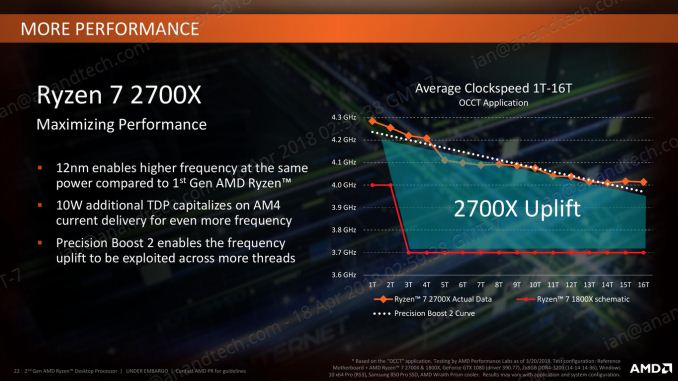
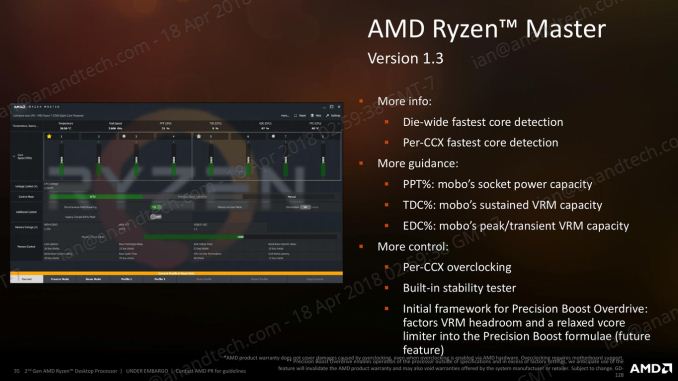

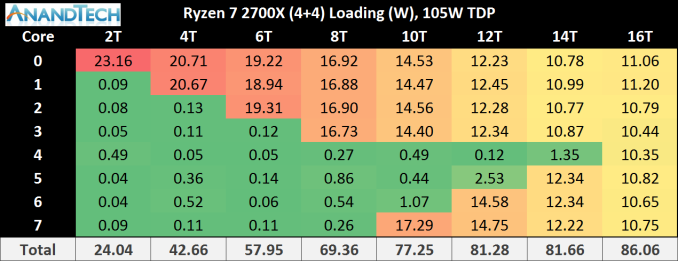
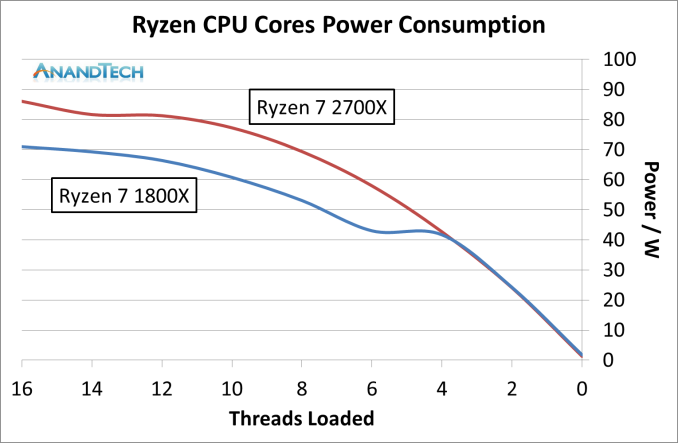
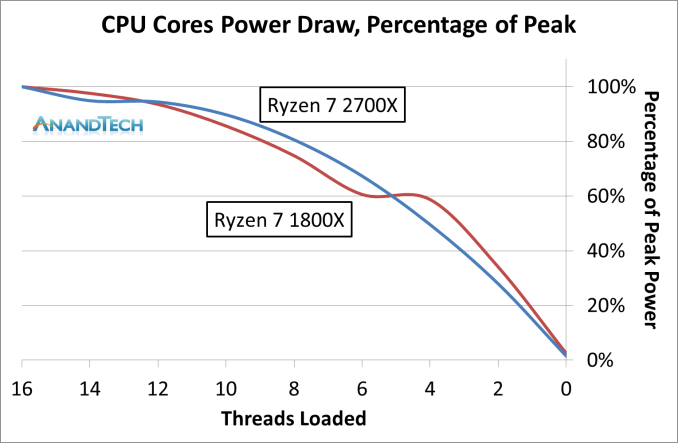
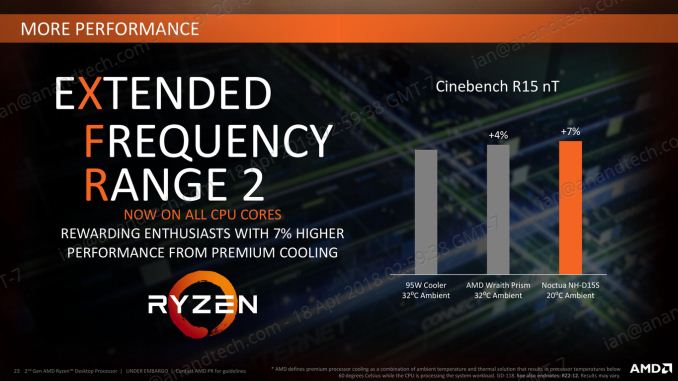








545 Comments
View All Comments
Luckz - Monday, April 23, 2018 - link
PB2/XFR2 seems to be all the overclocking anyone would want to do on Ryzen 2xxx (besides LN2 and other non-sustainable things)werpu - Friday, April 20, 2018 - link
Ahem those initial results were meltdown only and January, there have been a boatload of fixes since then on both the meltdown and spectre side. So the data is not correct anymore. Even in January VMs etc.. everything I/O intensive already encountered a serious performance hit.Crazyeyeskillah - Friday, April 20, 2018 - link
Those reviews haven't rerun the intel chip parts, hence the dated data.Azix - Thursday, April 19, 2018 - link
They used a 1080 in these tests. maybe thats a factor5080 - Thursday, April 19, 2018 - link
I think what you're seeing with the other reviews is old database information being used without the spectre and meltdown patches. They only say that Ryzen+ was tested with the latest patches, but it dosn't say that they retested all the Intel systems with the BIOS fix and patches applied.Ryan Smith - Thursday, April 19, 2018 - link
All of our Intel systems were re-run with the full Smeltdown fixes for this review.wicketr - Thursday, April 19, 2018 - link
It's be interesting to have an article running all these tests pre and post patches to show how much they affect the system. There seems to be a lot of confusion about how bad it is.Ryan Smith - Thursday, April 19, 2018 - link
It's definitely something we're intending to mine from the data later, after we're over this launch hump.5080 - Thursday, April 19, 2018 - link
That's what I thought and what Chris113q doesn'r realize.hescominsoon - Thursday, April 19, 2018 - link
Chris,You need to take into account the latest system/bios patches for meltdown/spectre as well. Anandtech is not manipulating the results. Just because they get "different" results from "everybody else"(especially when you fail to cite the differences), strains your credibility.